I’m not what you would call a “Star Wars fan.” I’ve seen most of the films and have played some of the games, but I won’t pretend to be a Star Wars buff or even someone who cares when a new Star Wars movie comes to the theater. And you bet your butt I’m not shelling out money for Disney+ just to watch The Mandalorian, despite how adorable Baby Yoda might be.
I think it’s important to preface this review with the above clause, because there’s a difference between a video game and a Star Wars video game—especially a triple-A single-player Star Wars video game developed by one of the most celebrated studios of this console generation.
All video games have to provide fantasies for the players, whether it’s as an adventurer in a sprawling kingdom like in Breath of the Wild or even as a wordsmith and puzzle-master in something like Baba is You. But when it comes to Star Wars games, those have to provide a very specific fantasy to players—namely, that they’re existing within the Star Wars universe.
Logically, I can sympathize with that. Rocksteady’s Batman: Arkham series provided the Batman fantasy that I’ve always wanted, and Insomniac achieved a comparable goal with last year’s Marvel’s Spider-Man. So on a basic human level, I can understand how Star Wars fans will look at Respwan’s Star Wars Jedi: Fallen Order and feel like they’re part of the fantasy.
But strip away that shiny Star Wars veneer and what’s left is a video game that’s taking apart a bunch of other video games and super glueing the pieces back together. Fallen Order is a Frankenstenian creation, or (to keep the metaphor within the Disney family) the Sid from Toy Story approach to making a game.
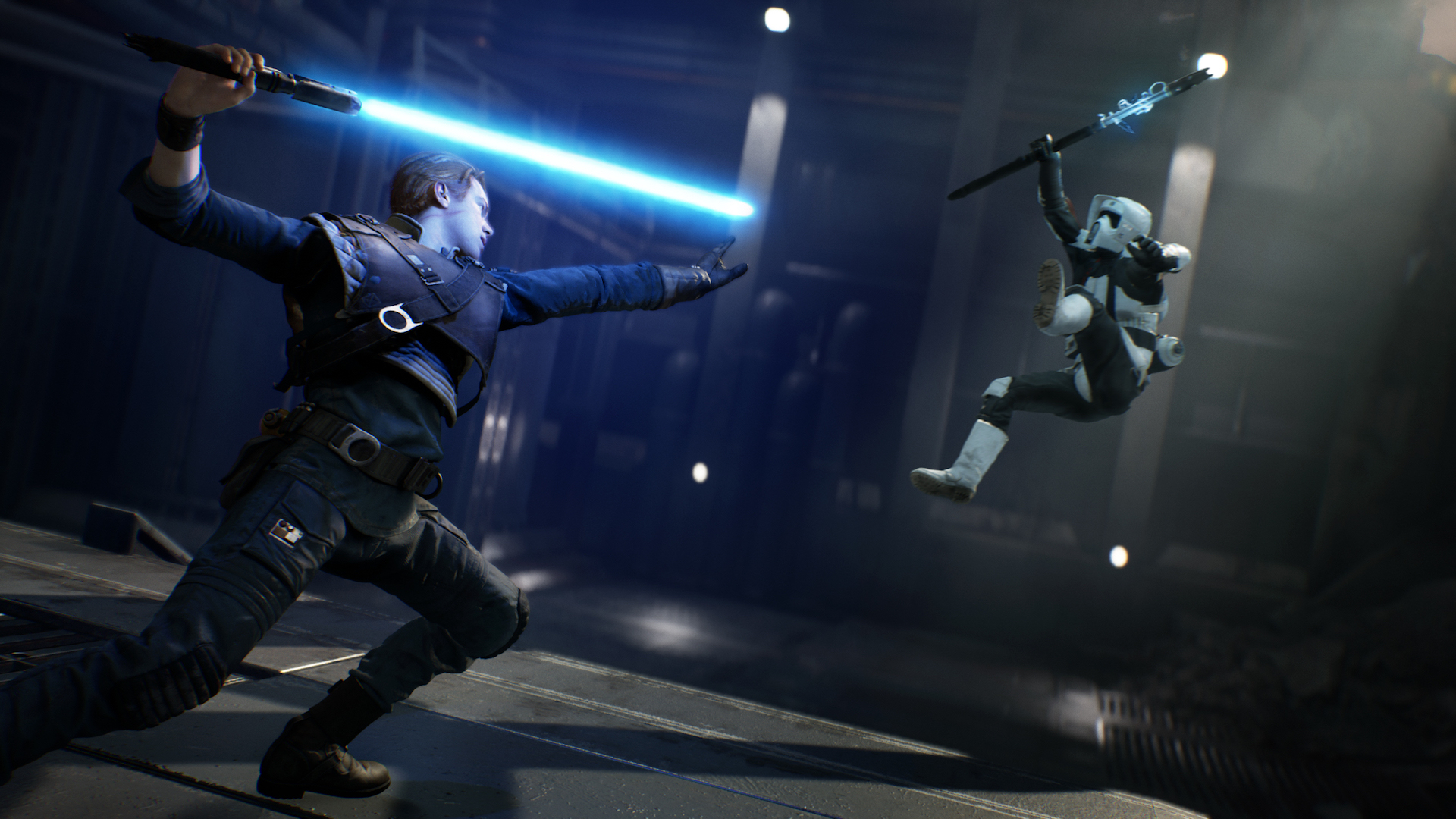
I know most games steal ideas from other games, okay? “Good artists copy, great artists steal” and all that. But, barring something like Dark Forces, which was just Star Wars Doom, it’s rare to see a game take ideas from other games while keeping those ideas so fully intact for a franchise as high-profile and visually iconic as Star Wars—you know, the franchise with lightsabers and the Stormtroopers and the guy who wears that black bucket on his head.
So reviewing Star Wars Jedi: Fallen Order is almost like reviewing two different experiences: the Star Wars fantasy, and the actual game. And it’s the former category where Fallen Order truly shines. Taking place between Revenge of the Sith and A New Hope, a decade or so after Senator Palpatine declared himself Emperor Palpatine and executed Order 66, Fallen Order opens with Padawan-in-hiding Cal Kestis (Cameron Monaghan) moonlighting as a scrapper on Bracca. In the heat of the moment after a workplace accident, Cal uses his innate Force abilities to save his friend’s life, which has the unintended consequence of setting the Empire and its Jedi-hunting Inquisitors after him. Just as he’s about to be made into lightsaber kebab, Cal is scooped up into a ship called the Mantis by Cere Junda (the excellent Debra Wilson, who makes every game she’s in better) and pilot Greez Dritus (Daniel Roebuck). Cal learns that Cere, who is a former Jedi Master, has been searching for him to help her uncover the secret of an ancient alien race’s vault that her own master, Eno Cordova (Tony Amendola), had been investigating before his disappearance. It turns out that the vault is protecting a holocron that contains the names of Force-sensitive children throughout the galaxy, and Cere wants to get that holocron to restore the Jedi Order and defeat the Empire. In order to do so, Cal needs to follow Cordova’s steps to find the key that will unlock the vault.
Star Wars Jedi: Fallen Order’s story is one of its best qualities, and that’s because Respawn’s writers clearly understood what makes a good Star Wars tale within the room given to them from the action-adventure genre. Hopping between planets, exploring ancient tombs, battling alongside resistance fighters and Wookiees, coming face-to-face with Dark Side adopters—Fallen Order has that sort of breathless, pulpy sense of adventure that George Lucas started off making, before he got too in the weeds with in-universe politics.
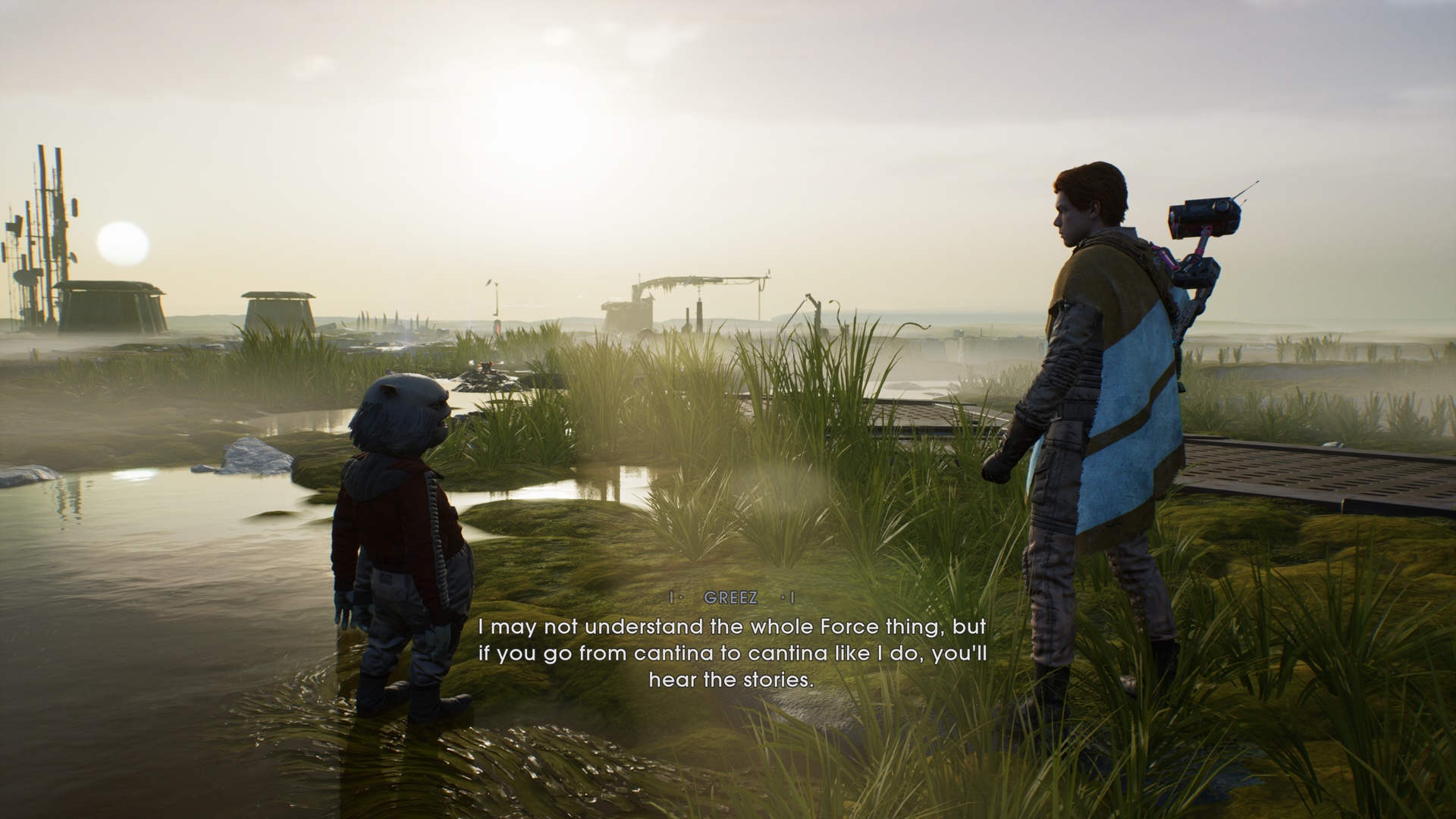
The characters, too, help bring that fantasy to life, and Star Wars Jedi: Fallen Order is one of the first Star Wars narratives I’ve experienced that attempts to explore the emotional fallout of Jedis that survived Order 66. Cal and Cere both have to deal with their own separate traumas from the Jedi Purge, with Cal having to relearn how to use the Force and Cere cutting herself off from it entirely. It also doesn’t hurt that Fallen Order introduces a villain in the Second Sister, an Empirical Inquisitor who’s backstory is as tragic as the protagonists’. But the real star of the show is BD-1, the tiny bipedal droid with a heart of gold who serves as Cal’s companion throughout the game. The connection Respawn has crafted between the player and BD-1 works both narratively and in terms of gameplay, with BD-1 providing contextual clues, a map, and the ever-important health stims. Surprisingly (or unsurprisingly maybe, given the franchise’s history), BD-1 also has an interesting backstory that pays off in one of the game’s most emotional story beats. Between Fallen Order and Titanfall 2, Respawn has proven it has a knack for crafting connections between the player and their mechanical sidekick.
Even as someone who isn’t a Star Wars fan per se, I found myself feeling giddy with how Respawn has brought the franchise to life. Traveling to Darth Maul’s home planet of Dathomir, exploring the Crystal Cave of Jedi holy land Ilum, and performing acrobatics across the treetops of Kashyyyk all provide for genuine thrills, which I imagine goes doubly for diehard fans. And the kid in me will never not think double-edged lightsabers are vastly cooler to their single-bladed counterparts. From the graphics to the art direction to the audio design, Respawn nails the fantasy of existing within the Star Wars universe.
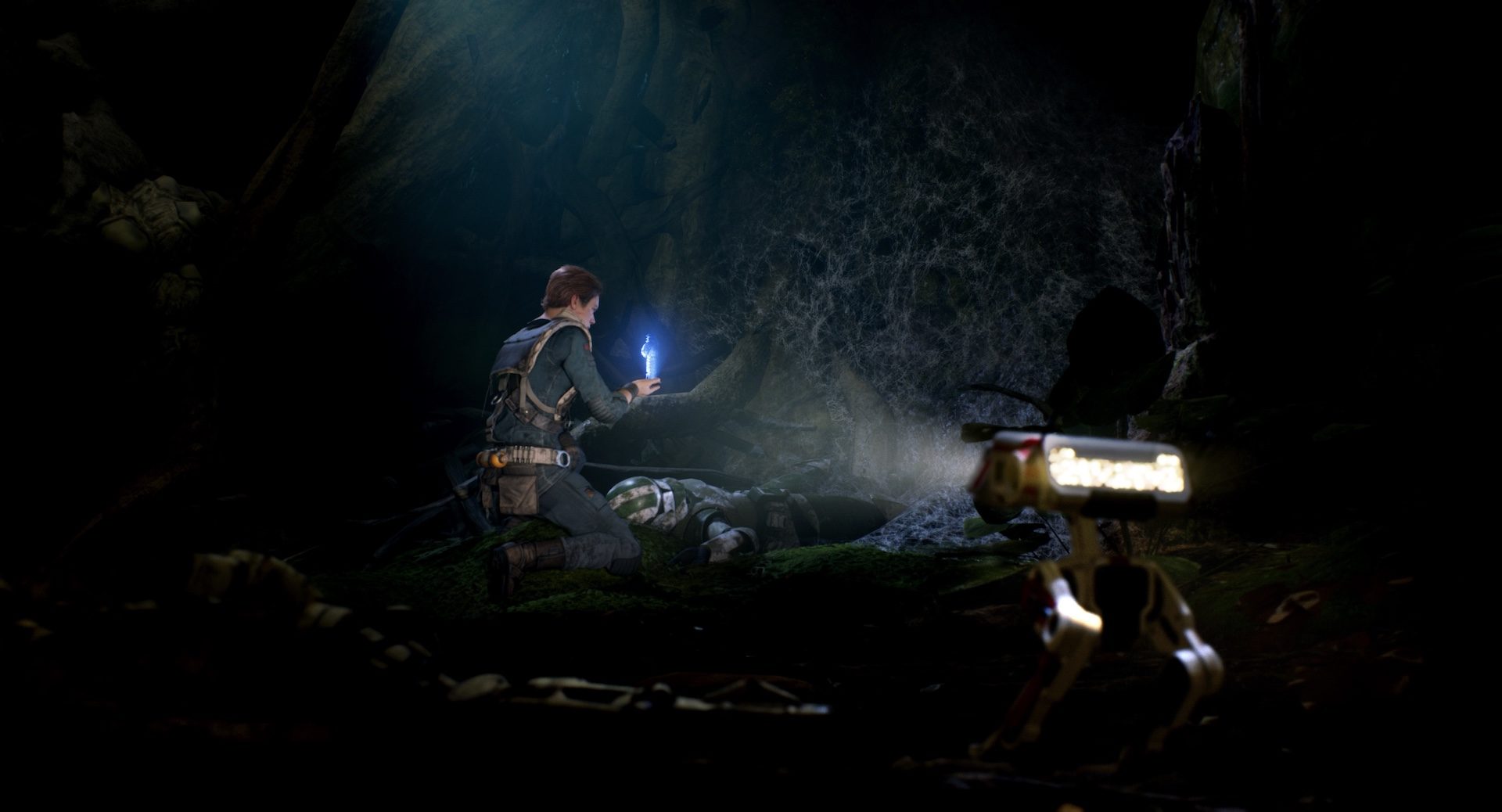
Where Fallen Order is less successful is in the way Respawn has stitched together different mechanics from a variety of different games. Echoing FromSoftware’s Sekiro: Shadows Die Twice and Souls series, Tomb Raider, Uncharted, and Metroid, Fallen Order’s gameplay is both laudable for stealing from quality sources and hindered by imperfect replication.
While it’s probably just a coincidence that both Sekiro and Fallen Order have pretty much identical philosophies when it comes to combat, it’s hard not to compare the two, and it’s not a comparison that’s favorable to the latter. Trading in a katana for a lightsaber, Fallen Order’s combat leans heavily on the same blocking and parrying mechanics that Sekiro perfected. Both Cal and his adversaries have block meters that need to be managed. Players must whittle down the enemies’ block meters with attacks and parries while also making sure Cal’s block meter doesn’t run out. It’s an obvious way to make lightsaber duels more satisfying than just hacking and slashing, but in Fallen Order it feels unresponsive and, at times, lost in the chaos of battle. Sekiro’s block meters are represented as bright orange bars that visually standout, which makes them both easy to track and signifies how crucial they are to the core of the game’s design. Fallen Order’s block meters, on the other hand, are thin white slivers that are easy to unintentionally ignore, especially as blaster fire and shock batons start raining down.
The other main problem with how Fallen Order implements blocking and parrying is how delayed the block actually is, particularly when trying to pull off multiple parries in succession. It might not seem like much, but the slight delay between letting go of the block button and pressing block again in order to catch an enemy in the middle of a combo means that, if you miss a parry the first time around, you just have to ride out the barrage of attacks by holding down block. It makes fighting enemies feel less like a satisfying tug of war and more like red rover. The window of opportunity for successfully parrying an attack changes depending on what difficulty level you’re playing on, too, which not only makes the entire mechanic feel somewhat arbitrary and ever-shifting, but it also means that if you’re playing on Jedi Master (Hard) or Jedi Grand Master (Very Hard), your window of opportunity is pretty darn thin.
Yes, I can hear the chanting of “git gud” coming from the choir as I type that, but by making the parry window adjustable, it also leads to enemy animations that aren’t nearly as clear and communicative as those in a game like Sekiro, which puts in the extra effort of giving a subtle visual clue for when an attack is coming in the form of a faint white trail off of enemy weapons. This is even more painfully true when it comes to non-human enemies or bosses who tend to flourish a bit with their lightsabers before going in for the kill. Round and round the lightsaber goes, but when to block, nobody knows. The fact that Cal’s slow block animation means you have to simply endure attacks if you miss the parry can become problematic when there are swarms of stormtroopers in the room. Combat then devolves into running around and taking cheap shots or simply dodge-rolling out of harm’s way, the invincibility window for which is absurdly generous. I almost defeated the final boss on Jedi Master by mashing dodge-roll and attacking after their combo string ended—until I gave up and just turned down the difficulty, making every muscle memory I’d gained up to then completely pointless.
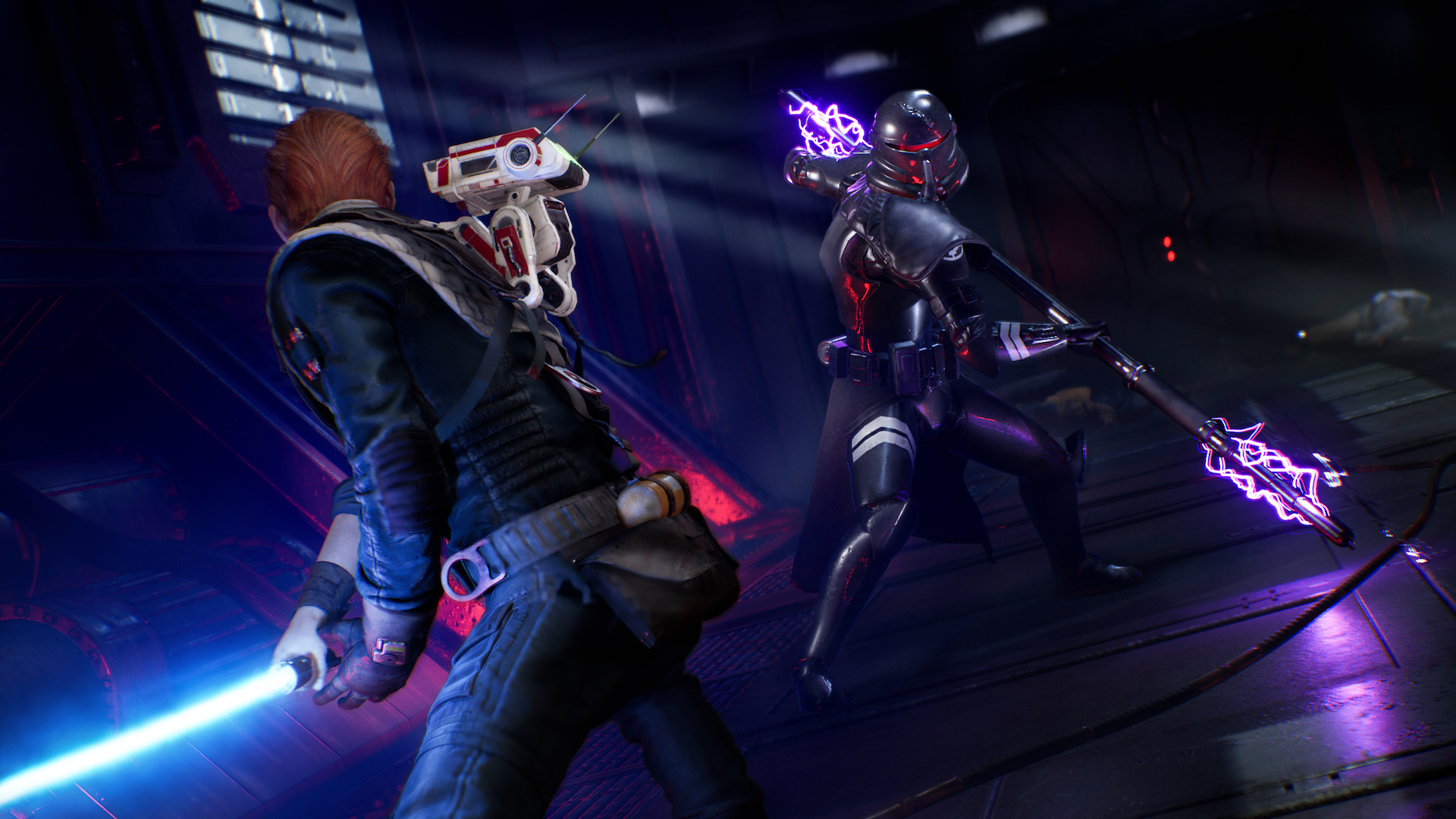
The other half of combat is utilizing Cal’s Force abilities, which you gradually unlock as the game’s story progresses. Narratively, doling out special Force moves one by one makes sense, as Cal’s time as a fugitive means that his connection to the Force has dulled, and it’s also a way for Respawn to move beyond areas throughout the world and make you come back to them later. But it also means that you’ll be missing out on a lot of the opportunity to feel strategic and creative until you start unlocking some of the later powers, especially Force Pull. What’s also weird is that the game ties your abilities to a Force meter, and the only way to refill it is to land attacks on enemies—or unlock an ability on the game’s skill tree that lets you fill your Force meter even if the enemy is blocking. For gameplay balance, it makes sense, as Respawn doesn’t want to give you infinite access to Force abilities. However, in a canon sense, I’m not sure Jedi strengthen their ties to the Force by killing people.
Then there’s the exploration, which takes cues from Tomb Raider, Uncharted, and—yes—Dark Souls. Throughout the game, the crew of the Mantis hops from planet to planet, with each one presenting a new, winding map to discover. When it comes to exploration, Respawn took cues from Dark Souls in the use of shortcuts and “meditation points” (basically this game’s version of bonfires), which allow you to refill your health stims and add points to your skill tree while also respawning all the enemies you’ve killed. (How that fits in with Star Wars lore is beyond me.) Again, Fallen Order suffers in comparison. The relief in finding shortcuts in Dark Souls comes from the gauntlet-like experience of getting there in the first place; resting at a bonfire truly feels like a respite, and the cleverness with how Dark Souls (specifically the first one) lays out its map means that finding a bonfire feels like a revelation. You can sometimes get that sense here, especially after some of the more annoying enemy encounters, but there’s something about the game’s maps that feel much more mechanical and obvious. They aren’t the mysterious, tightly coiled areas that From Software is so good at creating. Fallen Order’s maps feel more like hard-angled mazes, the kind you’d find on the back of a paper placemat at Bob Evans.
As far as traversal goes, that’s where the Tomb Raider and Uncharted comparisons come in. Fallen Order leans heavily into puzzle-platforming when it comes to its movement system, with the keyword there being “puzzle.” This isn’t the matter of platforming where timing and precision matters greatly, but the other one, where climbing and jumping feels like you’re locking the cogs of a meticulous watch into place. On the whole, it works for the game’s purposes, but it also makes getting from one place to the other feel like a chore. It doesn’t help that BD-1’s holomap is a tangle of blue, yellow, red, and green lights that is annoying to move around thanks to some sticky and spatially-challenged controls, and the fact that you can’t fast travel between different meditation points make them feel less useful while deterring the player from going back and getting to new, optional areas after unlocking the right Force abilities.
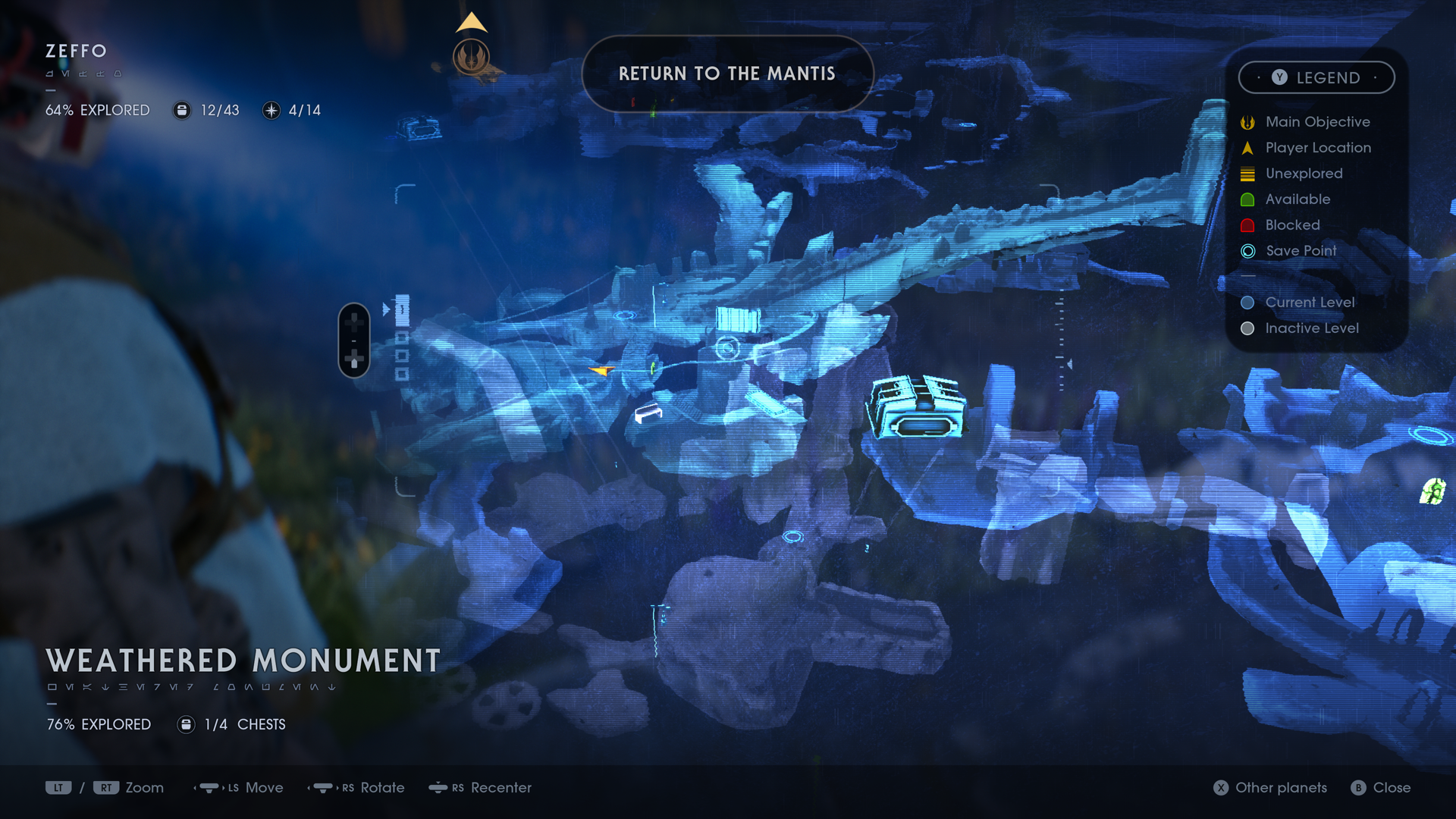
Electronic Arts’ Star Wars output has been notably turbulent ever since it secured its exclusivity deal with Lucasfilm and Disney. Between the cancelation of Amy Hennig’s Star Wars project, the subsequent closure of Visceral Games, and the loot box controversy that overshadowed every good thing about Star Wars Battlefront II and brought EA’s entire business model under Congress’ magnifying glass, the publisher has had a bad run with a franchise that should be making them way more money. In that context, Respawn’s efforts must seem like a beacon in the storm. As a Star Wars property, Fallen Order checks off every box for fans of the franchise looking for a fix. Even as someone who never caught the bug, I found myself grinning like an idiot at the effort that went into bringing the world to life.
But Star Wars Jedi: Fallen Order is a tale of two games. It doesn’t just want to be a Star Wars game. It wants to be a serious game, with serious challenges, and replicates the elements of more “serious games” without actually iterating in new or surprising ways. The approach of stealing ideas from great games is a smart one, and as a blueprint for future games in the series, Fallen Order definitely succeeds. But, as it is now, I’d rather be wielding a katana than a lightsaber.
All images: Electronic Arts
|
★★★☆☆
Star Wars Jedi: Fallen Order has its heart in the right place, delivering that Star Wars fantasy that is sure to please fans of the franchise. But putting aside the lightsabers and Wookiees, Fallen Order is too often unsuccessful in implementing ideas from better games, and ends up seeming like a pale imitation in comparison. |
Developer Respawn Entertainment Publisher Electronic Arts ESRB T - Teen Release Date 11.15.2019 |
| Star Wars Jedi: Fallen Order is available on PlayStation 4, Xbox One, and PC. Primary version played was for Xbox One. Product was provided by Electronic Arts for the benefit of this coverage. EGM reviews on a scale of one to five stars. | |

Michael Goroff has written and edited for EGM since 2017. You can follow him on Twitter @gogogoroff.